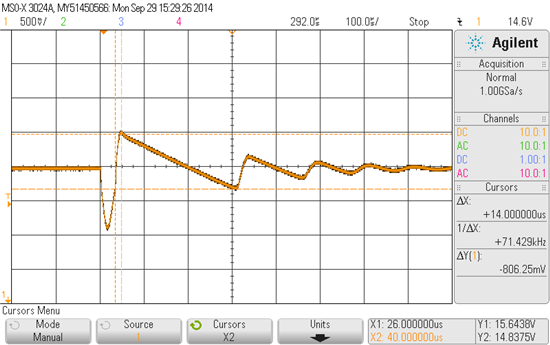We have an existing design using an LM317 with 24V in and 15V out. There is lots of input capacitance and 10u and 100n on the output. The Adjust pin is connected only to two resistors to set the output voltage. We have a 1Kohm continuous load and a switched 330mA load which is on for about 40us every few ms. We see a negative excursion to about 14V when the load switches on, then a positive excursion to about 15.5V at turn-off. So far, this is all expected. The 1K load causes a slow, linear discharge from 15.5V, which is different from the data sheet transient plots, but not surprising with light load and the output capacitance. The surprise comes when the linear discharge continues for about 300us, past the set-point and down to about 14.6V. Then there is another sharp positive edge, up to about 15.2V, and the slow, linear discharge starts again. This happens for about 6 cycles with each one being smaller and shorter than the previous, until the output settles at 15V, until the next load transient. This is not ringing any any normal sense, but an apparent switching behaviour in a device that should be linear. We can not explain why the regulator does not respond when the output decays to the setpoint, but waits for more than 100us, and then switches on, rapidly charging its output capacitor and overshooting again.
As a test only, we added 10u to the Adjust pin, and the unusual behaviour was mostly gone. We do not understand how transient response can be improved by adding phase delay to the feedback path. Unfortunately, this is a complex board, and it is difficult for us to just add this component. Right now, we are just trying to understand what we are seeing.


